Cosa vedere a Orvieto: la nostra miniguida ti spiega cosa vedere, cosa fare e cosa mangiare per scoprire Orvieto a 360°!
Orvieto, una delle città più antiche di Italia, deve le sue origini alla civiltà etrusca: i primi insediamenti risalgono al IX° secolo a.C. e si localizzarono all’interno delle grotte tufacee ricavate nel massiccio su cui sorge attualmente la cittadina umbra.
Sebbene la fama di Orvieto sia profondamente intrecciata con quella del suo magnificente duomo, la città offre numerosi spunti e itinerari storico-artistici, proprio in virtù delle sue antiche origini. Arroccata su di una rupe, inoltre, Orvieto offre scorsi panoramici davvero splendidi.
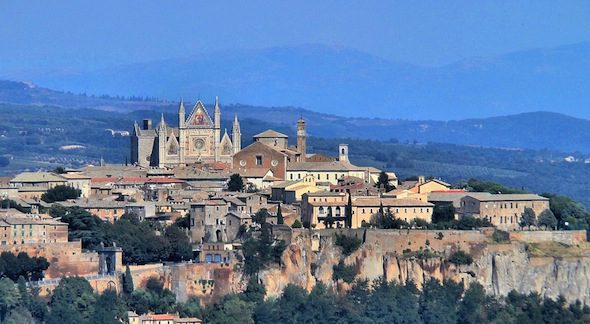
Cosa Vedere a Orvieto: la meraviglia del Duomo
Impossibile non iniziare il nostro tour orvietano dallo splendido Duomo di Orvieto, un variopinto esempio di architettura romanico-gotica, ricchissimo di opere d’arte, che custodisce al suo interno il Sacro Corporale.
Iniziato nel 1290, fu poi continuato da Lorenzo Maitani, al quale si deve in particolare la mirabile facciata con i suoi eccezionali bassorilievi; l’elegante fronte, largo 40 metri ed alto 52 m, è impreziosito da mosaici e dal rosone di Andrea Orcagna. L’interno del Duomo è ornato di importanti opere, tra le quali i celebri affreschi di Luca Signorelli e il Reliquiario del Corporale.
Gli affreschi della Cappella Nuova (eseguiti dal 1499 al 1504 da Luca Signorelli, che vi raffigurò Paradiso e Inferno, eletti e reprobi, scene con profeti, angeli e santi) vi lasceranno sicuramente senza fiato per la loro bellezza e la luminosità dei loro colori.
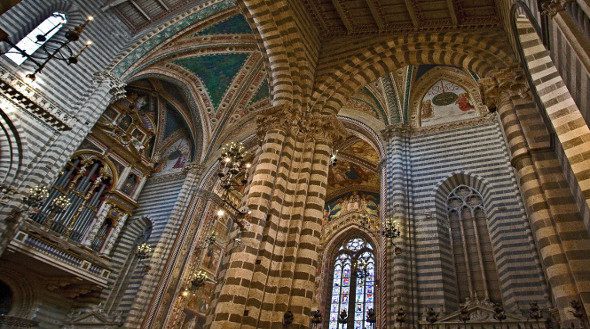
Nella cappella posta sul lato opposto della chiesa, si trova il Reliquiario del Corporale, un celebre capolavoro d’oreficeria eseguito nel 1337-1338 dal senese Ugolino di Vieri, che custodisce il Corporale che nel 1263 si macchiò di sangue allorché un prete boemo, celebrando la Messa senza fede, spezzò l’ostia consacrata, da cui fuoriuscì il sangue.
Nella parte posteriore del Duomo si trovano i Palazzi dei Papi, austeri edifici duecenteschi intitolati a Urbano IV, Martino IV, Bonifacio VIII. In quest’ultimo, detto anche Palazzo Soliano, si trova il Museo dell’Opera del Duomo.
Cosa fare a Orvieto
Dopo aver ammirato queste meraviglie, cosa fare a Orvieto?
Sicuramente immergersi nell’atmosfera senza tempo della Città Sotterranea che fu interamente ricavata dalle cavità scavate dagli abitanti nel corso dei secoli, ricca di pozzi e grotte. Il più famoso è probabilmente il Pozzo di San Patrizio, accanto ai giardini comunali che si trovano all’interno della Fortezza dell’Albornoz.
Il pozzo, straordinaria opera di ingegneria civile del Cinquecento, fu scavato per volere di Clemente VII, rifugiatosi ad Orvieto durante il sacco di Roma nel 1527. La sua realizzazione, voluta per motivi di sopravvivenza in caso di assedio o calamità naturali, fu affidata ad Antonio da Sangallo, coadiuvato da Giovanni Battista da Cortona.
Le sue dimensioni sono impressionanti: profondo 62 metri, ha un diametro di 13,5 metri. Tutt’attorno si snodano due scale a chiocciola elicoidali che non si incontrano mai; le due scalinate, composte da 248 gradini ognuna, ricevono luce da 72 finestre creando un’atmosfera surreale.
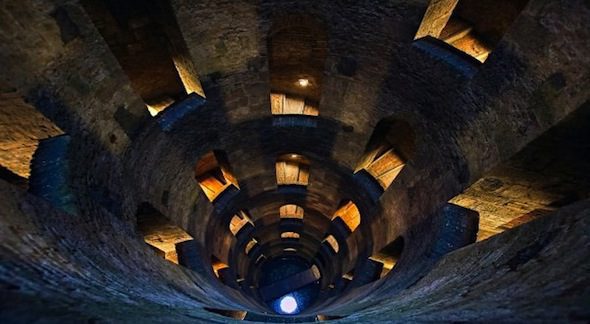
Non tutti sanno che… >> Il nome Pozzo di San Patrizio si deve all’analogia con la leggendaria caverna che si trovava su un’isola del Lough Derg, in Irlanda, meta di pellegrinaggio in epoca medievale.
Il sottosuolo della città riserva però ancora tante sorprese; a pochi passi dal Duomo i cunicoli e le cavità svelano un altro mondo da scoprire: è quello di Orvieto Underground, che consente di effettuare visite guidate in un complesso sotterraneo polivalente scavato a partire dal IX secolo a.C.; anche qui pozzi, cave, laboratori e frantoi per le olive hanno garantito la sopravvivenza degli abitanti in superficie per millenni.
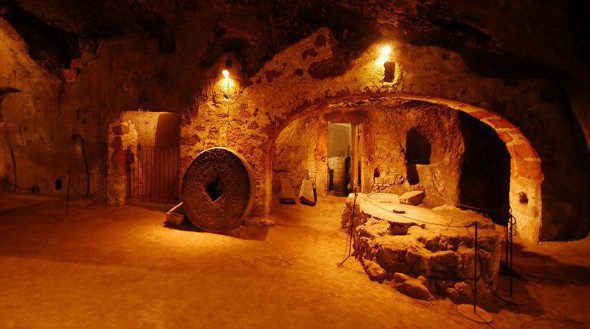
Orvieto è anche ricca di tradizioni; oltre alle funzioni religiose e all’esposizione della santa reliquia, esiste un corteo storico rievocativo che coinvolge 400 figuranti, e la Festa della Palombella, risalente al Trecento.
In quest’occasione viene fatta «volare» una colomba, legata a una raggiera scoppiettante di mortaretti su un cavo d’acciaio dalla chiesa di San Francesco al Duomo; la colomba viene poi donata alla prima coppia di sposi di quel giorno.
Cosa mangiare a Orvieto
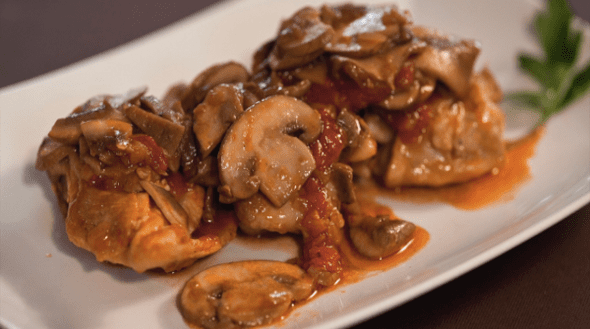
Dopo tanto camminare anche lo stomaco vuole la sua parte…per cui non potevamo non concludere la miniguida consigliandovi cosa mangiare a Orvieto!
Una particolarità unica è la Pera di Monteleone d’ Orvieto, detta anche “bistecca del villano” per la consistenza e per le sue incredibili proprietà nutritive; il piccione, la “palomba alla leccarda” ed il “pollo alla cacciatora” sono tra i piatti più antichi e tipici della città; come dessert vi consigliamo di provare i ciambelloni con l’anice.
Ma Orvieto è conosciuta soprattutto per il vino, il famoso Grechetto, ma anche Trebbiano e Sangiovese che vengono prodotti in enormi quantità, ed alcune eccellenze come la Muffa Nobile, prodotto doc.
>> Consulta i ristoranti migliori nella zona di Orvieto! Clicca e prenota
The best things to do in Orvieto. Our mini-guide tells you what to see, what to do and what to eat to discover Orvieto!
Orvieto, one of the oldest cities of Italy, owes its origins to the Etruscan civilization: the first settlements date back to the ninth century BC and were founded inside the tufaceous caves in the bedrock upon which today rises the Umbrian town.
Let’s start our tour from the beautiful Orvieto Cathedral, a colorful example of Romanesque-Gothic architecture, rich in art, which holds within the Holy Corporal. Started in 1290, it was later continued by Lorenzo Maitani, to whom we owe in particular the wonderful facade with its extraordinary bas-reliefs, the elegant front, 40 meters wide and 52 m high, is decorated with mosaics and the rose by Andrea Orcagna. The interior of the cathedral is adorned with important works, including the famous frescoes by Luca Signorelli and the Reliquary of the Corporal.
>> Do you want to visit Orvieto? Check it out now of the best hotels in Orvieto Italy

The frescoes in Cappella Nuova (performed by Luca Signorelli, who portrayed Heaven and Hell, elect and reprobate scenes with prophets, angels and saints) leave the visitor speechless with their beauty and brightness of their colors.
In the chapel on the opposite side of the church it is possible to find the Reliquary of the Corporal, a famous masterpiece executed by Ugolino di Vieri, who keeps the corporal who in 1263 became stained with blood when a Bohemian priest, celebrating the Mass without faith, broke the consecrated host, from which the blood came out.
At the rear of the cathedral are the Palaces of the Popes, austere buildings entitled to Urban IV, Martin IV, Boniface VIII. In the last one, also known as Palazzo Soliano, there is the Opera del Duomo Museum.
Things to do in Orvieto
After admiring this architectural marvels, what are the best things to do in Orvieto? Do not miss the timeless Underground City that was entirely derived from the cavity carved by the inhabitants over the centuries, full of pits and caves. The most famous is probably the St. Patrick’s Well, near the communal gardens and the Albornoz Fortress.
The well, extraordinary work of civil engineering of the sixteenth century, was excavated by order of Clement VII who found his refuge in Orvieto during the sack of Rome in 1527. Its implementation, desired for reasons of survival in case of siege or natural disaster, was entrusted to Antonio da Sangallo, assisted by Giovanni Battista da Cortona. Its dimensions are impressive: 62 meters deep, has a diameter of 13.5 meters. All around ther are two spiral staircases that never meet, the two steps, consisting of 248 steps each, are lit by 72 windows creating a surreal atmosphere.
>> Do you want to discover Orvieto’s treasures? Check it out now of the best farmhouse in Orvieto.

Perhaps you did not know that … >> The name of St. Patrick’s Well comes from the analogy with the legendary cave which was located on an island in Lough Derg, in Ireland, a place of pilgrimage in medieval times.
The subsoil of the city but still reserves many surprises, a few steps from the Duomo the tunnels and cavities reveal another world to discover: it is that of Orvieto Underground, which allows you to take guided tours in an underground complex multi dug from the ninth century BC, even here wells, quarries, workshops and olive presses have ensured the survival of the inhabitants in the area for millennia.
There are offers for vacation rentals and hotels in the areas of Orvieto! Click and Consult them immediately.
Orvieto is a place also rich in traditions. In addition to religious services and the exposure of the holy relic, there is a historical reminiscent procession involving 400 participants, and the famous Feast of Palombella, dating from the fourteenth century, which consists of making “fly” a dove, linked to a halo of crackling firecrackers on a steel cable from the church of San Francesco to the Cathedral; the dove is then given to the first married couple that day.
Orvieto’s food, Umbrian cuisine, Italian food
After all these walks you deserve to taste some typical food… so we could not finish the mini-guide without counsel you what to eat in Orvieto!
See the best restaurants in the area of Orvieto! >> Click here and book.

The pear Monteleone d”Orvieto, also called “steak of the villain” for its consistency and for its amazing nutritional properties; the pigeon, the “palomba alla leccarda” and “cacciatora” chicken are some of the oldest and most typical dishes of the city. As a dessert we suggest you to try the cakes with anise.
Above all Orvieto is known for its wine, the famous Grechetto, but also Trebbiano and Sangiovese that are produced in huge quantities, and some excellences as Muffa, product doc.
If you’ve decided to visit Orvieto and taste Umbrian cuisine you should contact now farmhouses near Orvieto >> click this link.
Notre petite guide vous explique quoi voir, quoi faire et quoi manger à Orvieto, pour découvrir la ville à 360°!
Orvieto, parmi les villes les plus anciennes d’Italie, a des origines étrusques: les premiers établissements remontent au XIe siècle a.C. Ils étaient localisés à l’intérieur des grottes de tuf taillés dans les roches, au-dessus desquelles cette merveilleuse ville de l’Ombrie se trouve aujourd’hui.
La visite d’Orvieto doit absolument commencer par le fascinant Dôme, an exemple d’architecture romaine-gothique très riche d’ouvres d’art. Le Dôme garde le Sacro Corporale: commencés en 1290, les travaux de la chapelle ont poursuivi avec Lorenzo Maitani, qui a réalisé aussi l’étonnante façade avec ses bas-reliefs exceptionnels. Le fronton, très élégant, a une hauteur de 52m et une largeur de 40m et il est enrichi par des mosaïques et par la rosace de Andrea Orcagna. L’interieut du Dôme est orné des ouvres d’art importantes, y compris les célèbres fresques de Luca Signorelli et le Reliquario del Corporale.
>> Voulez-vous visiter Orvieto? Découvrez les offres pour les meilleurs hôtels d’Orvieto

Voir les fresques de la Chapelle Nuova (réalisés entre le 1499 et le 1504 par Luca Signorelli, qui a peint le paradis et l’enfer, les élus et les méchants, les scènes avec les prophètes, les anges et les saints) consitue une expérience à couper le souffle. Les fresques sont d’une beauté et ont une luminosité des couleurs exceptionnelles.
Dans la chapelle qui se trouve à l’autre côté de l’église, il y a le Reliquario del Corporale, le célèbre chef d’ouvre de l’orfèvrerie qui a été réalisé en 1337-1338 par le siennois Ugolino di Vieri. Le Reliquario garde le Corporario, qu’en 1263 fut plein du sang: dès l’instant qu’un prêtre de la Bohême, en célébrant la messe sans aucune foi, cassa l’hostie consacrée, le sang commença à déborder d’elle.
Dans la partie posterièure du Dôme, il y a les Palais des Popes: ces batiments très austère du XIIIe siècle sont dédiés aux popes Urbano IV, Martino IV et Bonifacio VIII. Le Musée de l’Opera du Dôme se situe dans ce dernier, connu aussi sous le nom de Palais Soliano.
Quoi faire à Orvieto
Après les merveilles du Dôme, quoi faire a Orvieto? Sûrement, vous plongez dans la Cité Souterraine avec son atmosphère sans temps. Les souterrains d’Orvieto ont été complétement tirés des cavités creusés par les habitants au fil des siècles. Ils sont riches de grottes et puits, parmi lesquels le célèbre Puits de San Patrizio qui se trouve à coté des jardins de la Forteresse d’Albornoz.
Ce puits constitue une ouvre extraordinaire d’ingénierie civile du XVI, qui a été taillé selon la volonté de Clémente VII réfugiant à Orvieto pendant le Sac de Rome en 1527. Sa réalisation, ordonnée pour assurer la survie dans le cas d’un siège ou d’une catastrophe naturelle, fut confié à Antonio Sangallo et son assistant Giovanni Battista da Cortona.
Les dimensions du puits sont impressionnantes: il a une profondeur de 62 m et un diamètre de 13.5 m. Tout autour, deux escaliers en colimaçon s’articulent et reçoivent la lumière par 72 fenêtres qui créent un’atmosphère surréelle.
>> Voulez-vous découvrir la richesse historique et artistique d’Orvieto? Voici les meilleurs gites ruraux

Savez-vous que…. >> le nom du Puits de San Patrizio vient par analogie de la légendaire cave de l’Île Logh Derg, en Irlande, qui a été lieu de pèlerinage pendant le Moyen Age.
Les souterrains de la ville ont des autres surprises pour vous. À peu près du Dôme, parmi les galeries et les cavités, découvrez le monde d’Orvieto Underground, qui organise des visites guidées au coeur d’un complexe souterrain polyvalent qui a été taillé à partir du IXe siècle a.C. Même ici, les puits, les caves et les pressoirs des olives ont assuré la survie des habitants de la superficie pendant des millénaires.
Orvieto est une ville très riche de traditions: les célébrations religieuses, les expositions de la Sainte Relique, le cortège historique impliquant plus de 400 personnes et la Fête de la Palombella qui a eu origine dans le XIIe siècle.
La cuisine de l’Ombrie à Orvieto
Après une promenade, l’estomac veut sa partie… donc on termine cette petite guide avec notre conseils pour quoi manger à Orvieto!
>> Cliquez ici pour voir les meilleurs restaurants d’Orvieto et ses alentours!

La Pera di Monteleone d’Orvieto, connue aussi comme le beauf du méchant pour sa consistance et ses incroyables propriétés nutritionnelles, constitue un plat d’une particularité unique. Le pigeon, la palombe à la leccarda et le poulet à la cacciatora sont trois plats parmi les plus anciens et typiques de la ville.
Comme dessert, dégustez les délicieux ciambelloni à l’anis!
Orvieto est très connu aussi pour les vins, surtout pour le Grechetto et pour le Trebbiano et le Sangiovese, sans oublier les excellences comme la Muffa Nobile, produit doc.
>> Il y a des offres à Orvieto et ses alentours, découvrez les meilleurs hotels, b&b et gîtes ruraux
Bonne journée à Orvieto!
The best things to do in Orvieto. Our mini-guide tells you what to see, what to do and what to eat to discover Orvieto!
Orvieto, one of the oldest cities of Italy, owes its origins to the Etruscan civilization: the first settlements date back to the ninth century BC and were founded inside the tufaceous caves in the bedrock upon which today rises the Umbrian town. Let’s start our tour from the beautiful Orvieto Cathedral, a colorful example of Romanesque-Gothic architecture, rich in art, which holds within the Holy Corporal. Started in 1290, it was later continued by Lorenzo Maitani, to whom we owe in particular the wonderful facade with its extraordinary bas-reliefs, the elegant front, 40 meters wide and 52 m high, is decorated with mosaics and the rose by Andrea Orcagna. The interior of the cathedral is adorned with important works, including the famous frescoes by Luca Signorelli and the Reliquary of the Corporal.
>> Do you want to visit Orvieto? Check it out now of the best hotels in Orvieto Italy

The frescoes in Cappella Nuova (performed by Luca Signorelli, who portrayed Heaven and Hell, elect and reprobate scenes with prophets, angels and saints) leave the visitor speechless with their beauty and brightness of their colors.
In the chapel on the opposite side of the church it is possible to find the Reliquary of the Corporal, a famous masterpiece executed by Ugolino di Vieri, who keeps the corporal who in 1263 became stained with blood when a Bohemian priest, celebrating the Mass without faith, broke the consecrated host, from which the blood came out.
At the rear of the cathedral are the Palaces of the Popes, austere buildings entitled to Urban IV, Martin IV, Boniface VIII. In the last one, also known as Palazzo Soliano, there is the Opera del Duomo Museum.
Things to do in Orvieto
After admiring this architectural marvels, what are the best things to do in Orvieto? Do not miss the timeless Underground City that was entirely derived from the cavity carved by the inhabitants over the centuries, full of pits and caves. The most famous is probably the St. Patrick’s Well, near the communal gardens and the Albornoz Fortress.
The well, extraordinary work of civil engineering of the sixteenth century, was excavated by order of Clement VII who found his refuge in Orvieto during the sack of Rome in 1527. Its implementation, desired for reasons of survival in case of siege or natural disaster, was entrusted to Antonio da Sangallo, assisted by Giovanni Battista da Cortona. Its dimensions are impressive: 62 meters deep, has a diameter of 13.5 meters. All around ther are two spiral staircases that never meet, the two steps, consisting of 248 steps each, are lit by 72 windows creating a surreal atmosphere.
>> Do you want to discover Orvieto’s treasures? Check it out now of the best farmhouse in Orvieto.

Perhaps you did not know that … >> The name of St. Patrick’s Well comes from the analogy with the legendary cave which was located on an island in Lough Derg, in Ireland, a place of pilgrimage in medieval times.
The subsoil of the city but still reserves many surprises, a few steps from the Duomo the tunnels and cavities reveal another world to discover: it is that of Orvieto Underground, which allows you to take guided tours in an underground complex multi dug from the ninth century BC, even here wells, quarries, workshops and olive presses have ensured the survival of the inhabitants in the area for millennia.
There are offers for vacation rentals and hotels in the areas of Orvieto! Click and Consult them immediately.
Orvieto is a place also rich in traditions. In addition to religious services and the exposure of the holy relic, there is a historical reminiscent procession involving 400 participants, and the famous Feast of Palombella, dating from the fourteenth century, which consists of making “fly” a dove, linked to a halo of crackling firecrackers on a steel cable from the church of San Francesco to the Cathedral; the dove is then given to the first married couple that day.
Orvieto’s food, Umbrian cuisine, Italian food
After all these walks you deserve to taste some typical food… so we could not finish the mini-guide without counsel you what to eat in Orvieto!
See the best restaurants in the area of Orvieto! >> Click here and book.

The pear Monteleone d”Orvieto, also called “steak of the villain” for its consistency and for its amazing nutritional properties; the pigeon, the “palomba alla leccarda” and “cacciatora” chicken are some of the oldest and most typical dishes of the city. As a dessert we suggest you to try the cakes with anise.
Above all Orvieto is known for its wine, the famous Grechetto, but also Trebbiano and Sangiovese that are produced in huge quantities, and some excellences as Muffa, product doc.
If you’ve decided to visit Orvieto and taste Umbrian cuisine you should contact now farmhouses near Orvieto >> click this link.
The best things to do in Orvieto. Our mini-guide tells you what to see, what to do and what to eat to discover Orvieto!
Orvieto, one of the oldest cities of Italy, owes its origins to the Etruscan civilization: the first settlements date back to the ninth century BC and were founded inside the tufaceous caves in the bedrock upon which today rises the Umbrian town. Let’s start our tour from the beautiful Orvieto Cathedral, a colorful example of Romanesque-Gothic architecture, rich in art, which holds within the Holy Corporal. Started in 1290, it was later continued by Lorenzo Maitani, to whom we owe in particular the wonderful facade with its extraordinary bas-reliefs, the elegant front, 40 meters wide and 52 m high, is decorated with mosaics and the rose by Andrea Orcagna. The interior of the cathedral is adorned with important works, including the famous frescoes by Luca Signorelli and the Reliquary of the Corporal.
>> Do you want to visit Orvieto? Check it out now of the best hotels in Orvieto Italy

The frescoes in Cappella Nuova (performed by Luca Signorelli, who portrayed Heaven and Hell, elect and reprobate scenes with prophets, angels and saints) leave the visitor speechless with their beauty and brightness of their colors.
In the chapel on the opposite side of the church it is possible to find the Reliquary of the Corporal, a famous masterpiece executed by Ugolino di Vieri, who keeps the corporal who in 1263 became stained with blood when a Bohemian priest, celebrating the Mass without faith, broke the consecrated host, from which the blood came out.
At the rear of the cathedral are the Palaces of the Popes, austere buildings entitled to Urban IV, Martin IV, Boniface VIII. In the last one, also known as Palazzo Soliano, there is the Opera del Duomo Museum.
Things to do in Orvieto
After admiring this architectural marvels, what are the best things to do in Orvieto? Do not miss the timeless Underground City that was entirely derived from the cavity carved by the inhabitants over the centuries, full of pits and caves. The most famous is probably the St. Patrick’s Well, near the communal gardens and the Albornoz Fortress.
The well, extraordinary work of civil engineering of the sixteenth century, was excavated by order of Clement VII who found his refuge in Orvieto during the sack of Rome in 1527. Its implementation, desired for reasons of survival in case of siege or natural disaster, was entrusted to Antonio da Sangallo, assisted by Giovanni Battista da Cortona. Its dimensions are impressive: 62 meters deep, has a diameter of 13.5 meters. All around ther are two spiral staircases that never meet, the two steps, consisting of 248 steps each, are lit by 72 windows creating a surreal atmosphere.
>> Do you want to discover Orvieto’s treasures? Check it out now of the best farmhouse in Orvieto.

Perhaps you did not know that … >> The name of St. Patrick’s Well comes from the analogy with the legendary cave which was located on an island in Lough Derg, in Ireland, a place of pilgrimage in medieval times.
The subsoil of the city but still reserves many surprises, a few steps from the Duomo the tunnels and cavities reveal another world to discover: it is that of Orvieto Underground, which allows you to take guided tours in an underground complex multi dug from the ninth century BC, even here wells, quarries, workshops and olive presses have ensured the survival of the inhabitants in the area for millennia.
There are offers for vacation rentals and hotels in the areas of Orvieto! Click and Consult them immediately.
Orvieto is a place also rich in traditions. In addition to religious services and the exposure of the holy relic, there is a historical reminiscent procession involving 400 participants, and the famous Feast of Palombella, dating from the fourteenth century, which consists of making “fly” a dove, linked to a halo of crackling firecrackers on a steel cable from the church of San Francesco to the Cathedral; the dove is then given to the first married couple that day.
Orvieto’s food, Umbrian cuisine, Italian food
After all these walks you deserve to taste some typical food… so we could not finish the mini-guide without counsel you what to eat in Orvieto!
See the best restaurants in the area of Orvieto! >> Click here and book.

The pear Monteleone d”Orvieto, also called “steak of the villain” for its consistency and for its amazing nutritional properties; the pigeon, the “palomba alla leccarda” and “cacciatora” chicken are some of the oldest and most typical dishes of the city. As a dessert we suggest you to try the cakes with anise.
Above all Orvieto is known for its wine, the famous Grechetto, but also Trebbiano and Sangiovese that are produced in huge quantities, and some excellences as Muffa, product doc.
If you’ve decided to visit Orvieto and taste Umbrian cuisine you should contact now farmhouses near Orvieto >> click this link.

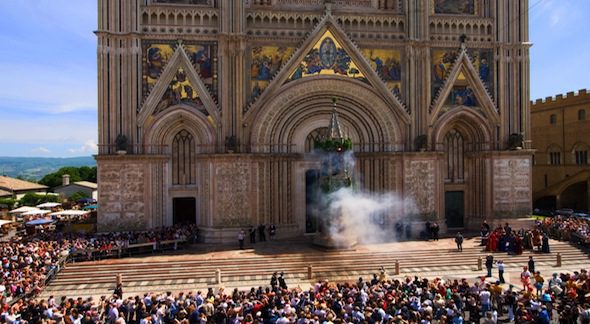





Comment (0)